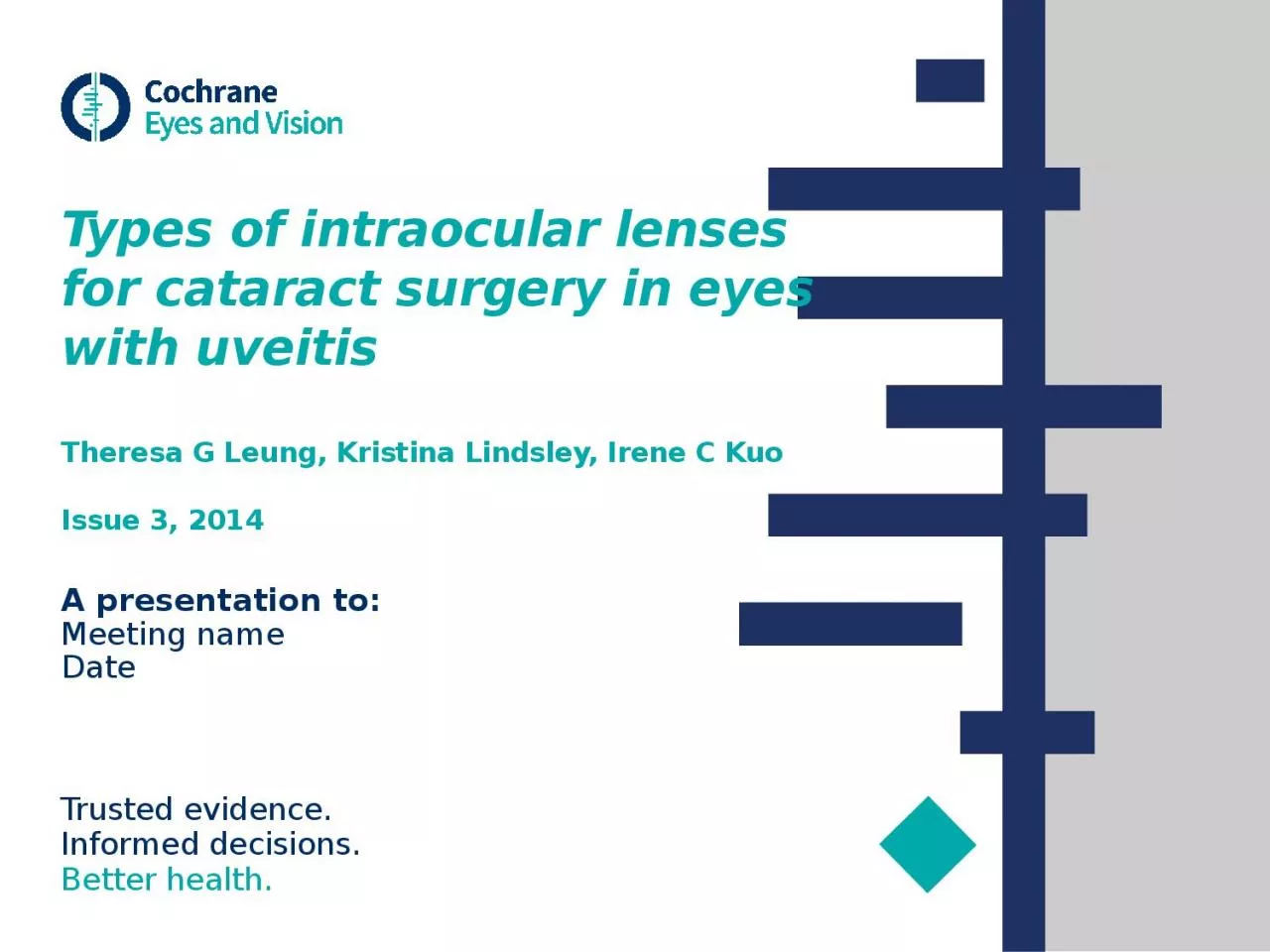

Theresa G Leung Kristina Lindsley Irene C Kuo Issue 3 2014 A presentation to Meeting name Date Table of Contents 01 Background 02 Types of studies 03 Key results 04 Tables Risk of BiasForest Plots ID: 929635
Download Presentation The PPT/PDF document "Types of intraocular lenses for cataract..." is the property of its rightful owner. Permission is granted to download and print the materials on this web site for personal, non-commercial use only, and to display it on your personal computer provided you do not modify the materials and that you retain all copyright notices contained in the materials. By downloading content from our website, you accept the terms of this agreement.
Slide1
Types of intraocular lenses for cataract surgery in eyes with uveitisTheresa G Leung, Kristina Lindsley, Irene C Kuo Issue 3, 2014
A presentation to:
Meeting name
Date
Slide2Table of Contents01
Background
02
Types
of studies
03
Key results
04
Tables (Risk of Bias/Forest Plots)
05
Conclusions
06
Acknowledgements
Slide301: BackgroundCataract formation is a major complication that stems from uveitis Following cataract surgery, intraocular lenses (IOLs) are inserted into the eye to replace the natural lens
OBJECTIVE:
To summarize th
e effects of different IOLs on visual outcomes and quality of life in people with uveitis
Slide402: Types of studiesParticipants216 participants, four RCTsInterventionsHydrophobic acrylic IOL, silicone IOL, heparin surface modification poly(methyl methacrylate) (PMMA) IOL or non-modified PMMA IOL
HSM PMMA IOL or unmodified PMMA IOL
Hydrophobic IOL or hydrophilic acrylic IOL
Slide503: Key resultsHydrophobic acrylic IOL, silicone IOL, heparin surface modification poly(methyl methacrylate) (PMMA) IOL or non-modified PMMA IOL
“
Proportions of participants with one or more Snellen lines of visual improvement were similar among the four treatment groups at one year'
follow-up…”
“
At one year' follow-up, fewer eyes randomized to hydrophobic acrylic IOLs developed posterior
synechiae
when compared with eyes receiving silicone
IOLs (RR 0.18, 95% CI 0.04 to 0.79)”
“…the
effects between these groups were less certain with respect to developing posterior capsule
opacification…,
corneal
edema…, cystoid
macular
edema…,
or mild IOL
decentration
.”
Slide603: Key results (continued)HSM PMMA IOLs versus unmodified PMMA IOLs“Two intra-individual studies also compared HSM PMMA IOLs with unmodified PMMA IOLs at three or six months of
follow-up.”
“
These studies, including a combined total of 16 participants with uveitis, were insufficiently powered to detect differences in outcomes
…”
Slide703: Key results (continued)Hydrophobic or hydrophilic acrylic IOL“At three months, there were no statistical or clinical differences between hydrophobic and hydrophilic acrylic IOL types in the proportions of participants with two or more Snellen lines of visual
improvement…”
RR 1.03, 95% CI 0.87 to 1.22
“There
were similar rates in the development of PCO between hydrophobic or hydrophilic acrylic IOLs at six months'
follow-up…”
RR 1.00, 95% CI 0.80 to 1.25
Slide804: Tables
Slide905: Conclusions“…there is uncertainty as to which type of IOL provides the best visual and clinical outcomes in people with uveitis undergoing cataract surgery.”
“
Evidence of a superior effect of hydrophobic acrylic lenses over silicone lenses, specifically for posterior
synechiae
outcomes comes from a single study at a high risk of performance and detection bias.
”
Slide1006: AcknowledgementsCochrane Eyes and Vision US Satellite, funded by the National Eye Institute, National Institutes of HealthCochrane Eyes and Vision Editorial Base
, funded by
the UK National
Health Service
Research
and
Development
Programme
Theresa G Leung, Kristina
Lindsley
, Irene C
Kuo
Review citation
Leung TG,
Lindsley
K,
Kuo
IC. Types of intraocular lenses for cataract surgery in eyes with uveitis. Cochrane Database of Systematic Reviews 2014, Issue 3. Art. No.: CD007284. DOI: 10.1002/14651858.CD007284.pub2